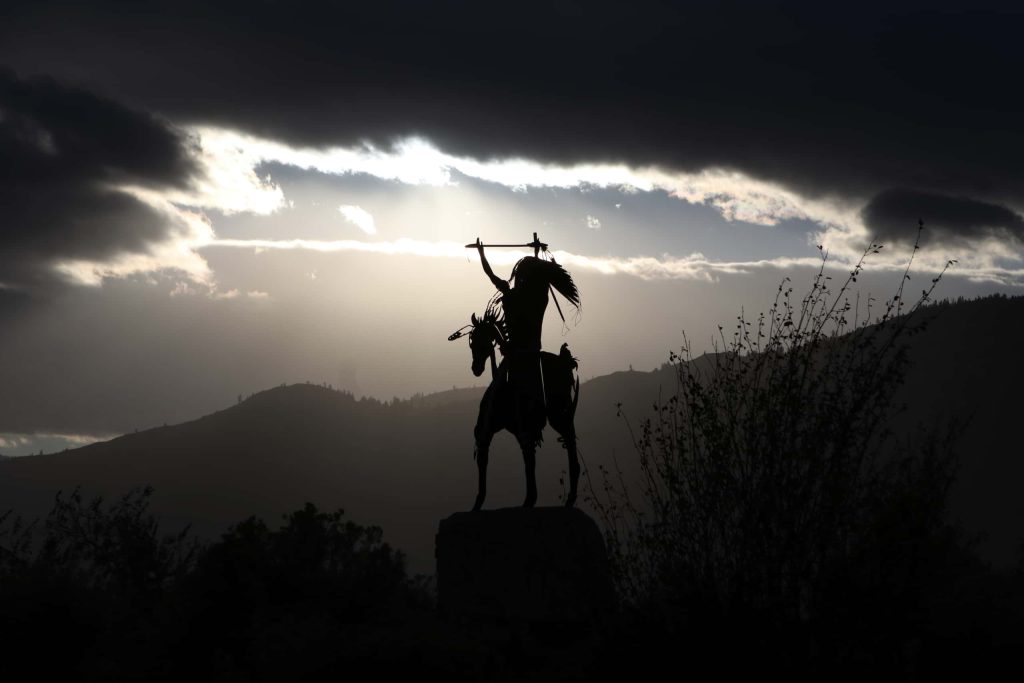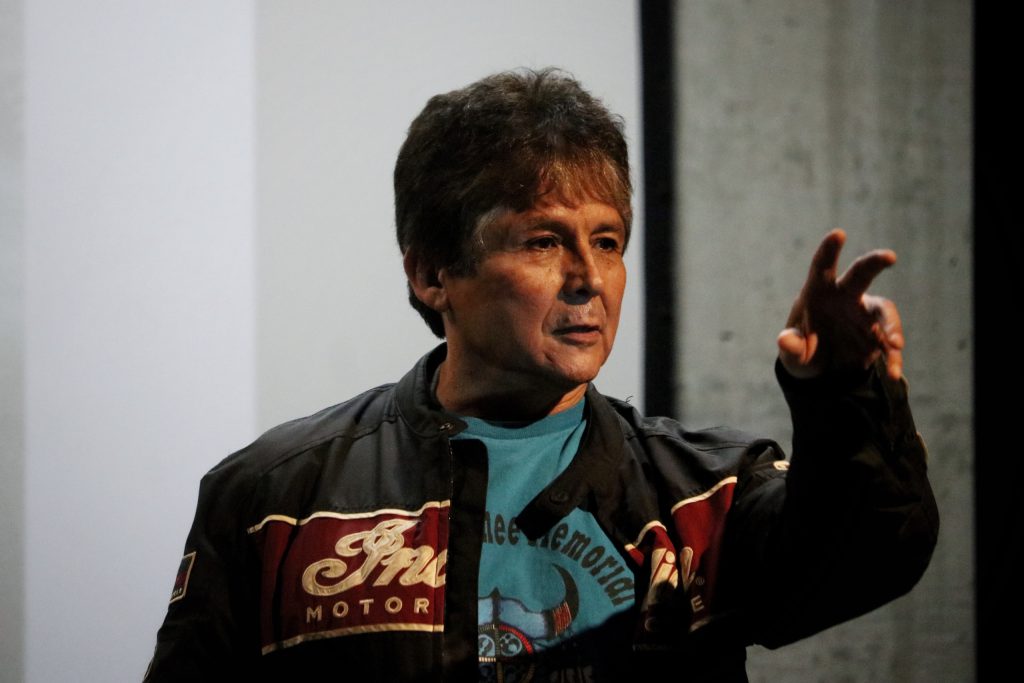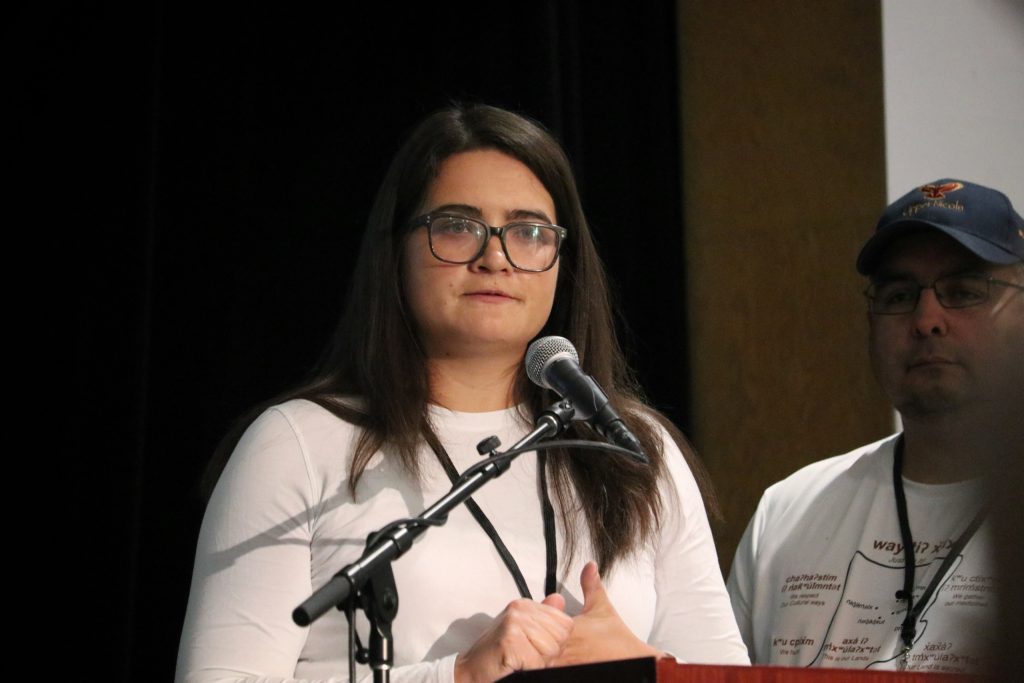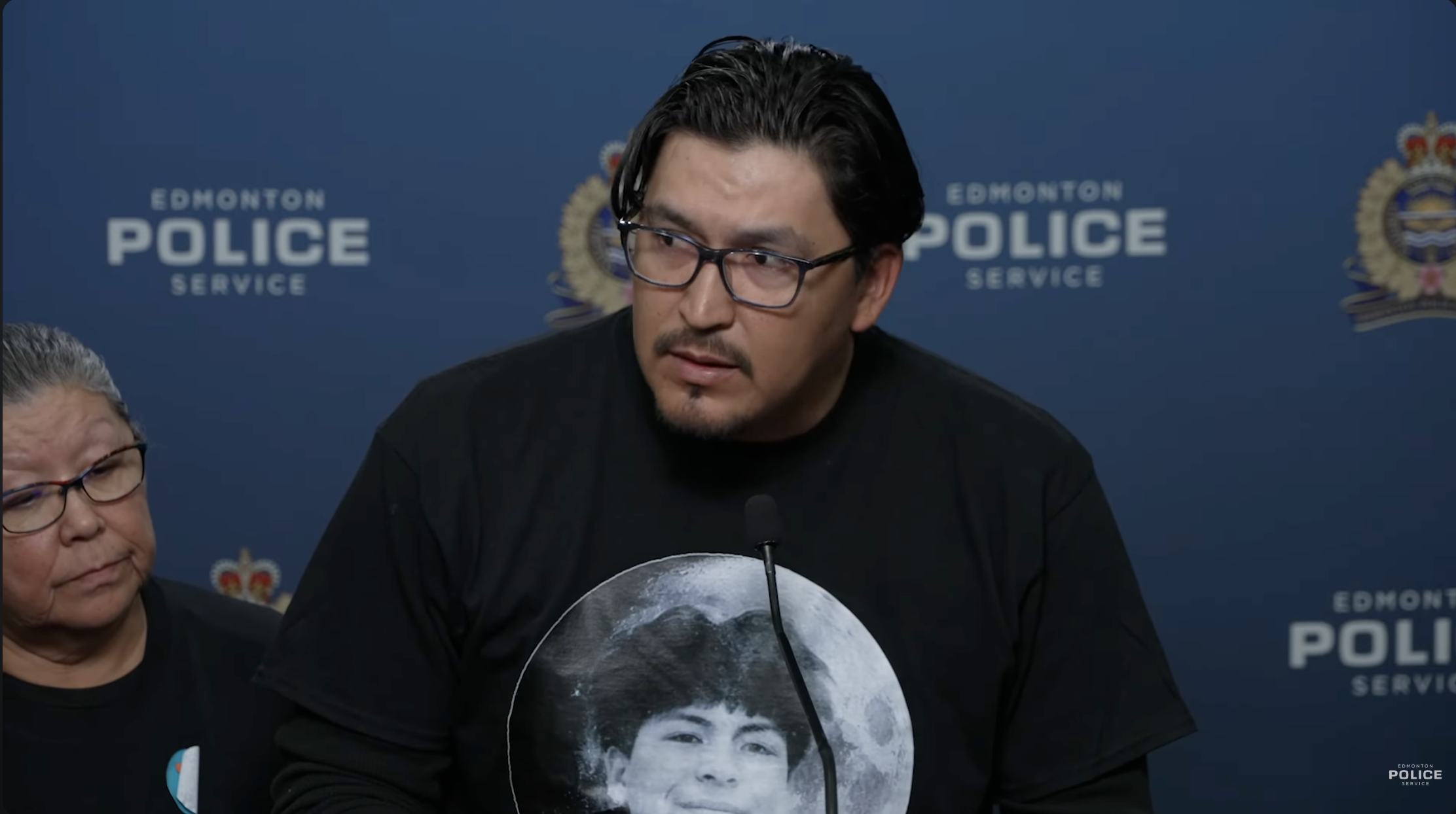syilx conservation knowledge at the heart of water forum in sw̓iw̓s
The fourth nk’mip (Osoyoos Lake) Water Forum intersected captikʷł teachings with Western science


On the opening night of a water forum overlooking nk’mip (Osoyoos Lake), a Colville Elder set the tone for the three-day event by introducing the waters as a syilx relation and spirit.
Standing in front of a crowd of scholars, residents, scientists and elected officials gathered inside the theatre at the Nk’Mip Desert Cultural Centre — ML KNOOPS (Eagle) Arnie Marchand opened the event in sw̓iw̓s (Osoyoos).
“To me, water is my relative,” Marchand said.
“It’s part of me. It brings 60 per cent of my nourishment to me. It’s just a part of everything — the land could not be without water. We could not be without the land.”
This theme of this year’s nk’mip (Osoyoos Lake) Water Forum, which Marchand took part in conceptualizing, was “The Heart of the Watershed: Bridging Indigenous and Western approaches to Knowledge, Science and Management.”
Marchand highlighted that nk’mip is geographically located at the centre of syilx territories, calling it the “heart and soul of the Okanagan.”
Woven throughout the three-day conference, from Oct. 27 to 29, was an overarching value system that called upon Western scientists to trust, respect, learn and uplift Indigenous laws, values and teachings — encouraging them to understand the correlation that these values have on land and water stewardship.
The water forum was hosted by local nations, the Town of Osoyoos, the International Joint Commission and the Okanagan Basin Water Board.
Throughout the event, Indigenous Peoples spoke of how crucial it is to have traditional ecological knowledge be at the guiding forefront of both water and land management.
Woven with Western science sessions on topics such as climate change impacts, managing lake water levels and fisheries restoration — various syilx knowledge-holders from both sides of the colonial border spoke about their time-old stewardship of nk’mip and surrounding waterways.
Teachings of the captikʷł
Also on the first day of the event, y̓ilmixʷm ki law na Chief Clarence Louie of the Osoyoos Indian Band (OIB) introduced forum-goers to the captikʷł — a set of teachings and values that define the syilx Nation’s rights, responsibilities and relation to the land.
Louie spoke of the importance of caring for the water quality for the Salmon People, and how the lessons of the captikʷł are equal to those found in the Christian bible.

Before any decisions that would impact the land and water are made, Louie shared that everyone should consider the well-being of the land, the four-legged relatives, the Salmon People and lastly human beings.
“Humans’ needs — and if we are going to be OK — come last, after the Salmon People especially,” he said.
“When we talk about the Salmon People returning each year, those are our relatives. None of us would be around here today if it wasn’t for the Salmon People.”
The captikʷł served as the foundation of the conference throughout its entire duration, with facilitators Kelly Terbasket of Lower Similkameen Indian Band and Aaron Derickson of Westbank First Nation regularly weaving its teachings and values — specifically the Four Food Chiefs — throughout panel discussions at the Sonora Community Centre in sw̓iw̓s.
Terbasket explained how embedded in siwɬkʷ, the nsyilxcən word for water, is the syilx belief that the right to water is equal for both humans and animals. “siw” is derived from “siwst,” which means for humans to drink, while “ɬkʷ” comes from “ɬkʷitkʷ,” which means for animals to lap.
“The wellness of our water is the wellness of all,” said Terbasket.
The pair broke down the creation story of the Four Food Chiefs – skəmxist (Bear), spitl’əm (Bitterroot) siyaʔ (Saskatoon Berry) and n’tyxtix (Salmon) – and regularly asked forum participants to reflect on which Food Chief they identified with the most when it comes to managing water. She explained that skəmxist represents tradition; spitl’əm represents relationships; siyaʔ represents innovation and n’tyxtix represents action.
“The Four Food Chiefs, the captikʷł, gives us our laws and protocols to change the future. It shows us how to work together and include all these perspectives – everybody’s perspective,” said Brian Holmes of Upper Nicola Band.
“The sacrifices we need to make to ensure the future can survive. Our relationship with each other will determine our path forward.”
ks‿kəɬqayxʷntim iʔ siwɬkʷ
Both Holmes and Tessa Terbasket of Lower Similkameen Indian Band presented the syilx Nation’s siwɬkʷ water strategy, ks‿kəɬqayxʷntim iʔ siwɬkʷ (We will protect the water). Terbasket described the strategy’s vision as one that promises to look at water in a holistic manner.
“It’s not just about our human-centric needs about water anymore — we really need to move forward thinking about all the other life forms within our local ecosystems and how they coexist, how we live in harmony and balance with that,” said Terbasket.
“How do we restore and protect our watersheds? Because we are in a crucial time where if we don’t, we’re heading into a very bad place, as our Elders would say.”

Through teachings from Elders, Terbasket said that if everyone living in the Okanagan Valley upheld syilx water rights, then the water would have a voice and be protected.
“We hear a lot in this day and age of, ‘How do we give this river legal rights or human rights?’ But if we actually upheld the syilx rights, that would happen,” she said.
While the siwɬkʷ water strategy upholds syilx principles of stewardship, Terbasket said that collaboration is necessary, and having allies learn by reading the document is a good first step in working together.
“Gatherings like this today, gathering as syilx and non-syilx in the valley — whether it’s through water forums, inviting you to ceremonies — is so important in our relationship building,” she said.
Two-eyed seeing
Gwen Bridge, an environmental scientist from Saddle Lake Cree Nation, said that in order to build relationships and reconcile, the first relationship that must heal is the relationship that Indigenous people have to their land.
If science wants to get anywhere, Bridge said that Indigenous and non-Indigenous knowledge must come together to create a collective vision, a concept she called “two-eyed seeing.”

“We really need to work together, because when you put those two eyes together, you have these two inputs: a unique input from each,” she said. “And what happens in the brain? Something magical, cool and creative. All of the sudden, we have this focus, this common target.”
She referred to the Ethical Space Framework that she learned from Reg Crowshoe, a Piikani Blackfoot Elder, which is a space of creativity where knowledge systems aren’t integrated or overlapped. Rather, it’s a place where a new school of thought is created.
“It’s really important to bring what’s important from both of those eyes — those systems — put it into this ethical space and create something new,” she said. “This should occur within a place of cultural safety, where we take the protocols of various nations — in this case Okanagan/syilx Nation — on how you come to agreement.”
When talking about ethical space and reconciliation, Bridge said that people should aim to reconcile what process of decision-making has the authority.
“I think that’s what Indigenous people have been saying: your system is no more valid than ours,” she said.
She called on Western scientists to trust Indigenous people to facilitate the decisions on the land, which will result in not only the betterment of the two systems, but for the collective wellbeing of all living things.
“If you’re trying to do anything without understanding or relationship, you will have no outcome but conflict,” she said.
“This understanding of relationships is not the relationship between you or me or groups of people, it’s the understanding of relationship that Indigenous people have to the animals, and the animals have within themselves — the tmixʷ (all living things) and the tmxʷulaxʷ (the land).”
Reporting for this story was made possible in part through a grant from the Institute for Journalism and Natural Resources and the Gordon and Betty Moore Foundation.
Author
Latest Stories
-
‘Bring her home’: How Buffalo Woman was identified as Ashlee Shingoose
The Anishininew mother as been missing since 2022 — now, her family is one step closer to bringing her home as the Province of Manitoba vows to search for her
-
‘He was full of spirit, promise and love’: Police confirm Samuel Bird is presumed dead as search area narrows
Remains of the 14 year old, whose spirit name is Achakapis, are believed to be ‘no more than 150 km’ from ‘Edmonton,’ according to investigators












